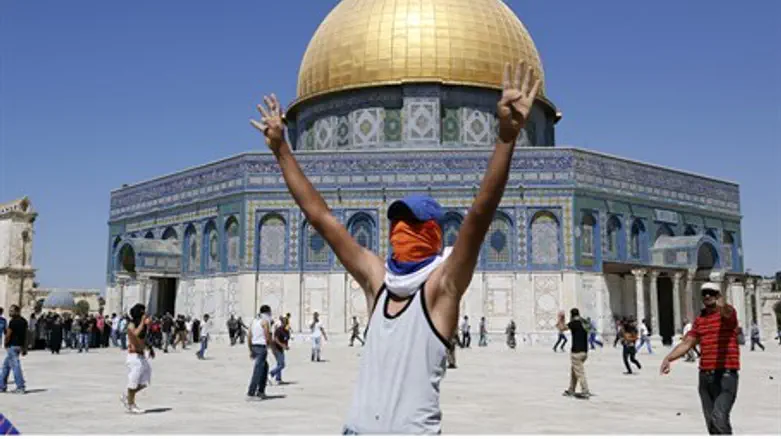
This article is the second in a series exploring the "status quo" on Jerusalem's Temple Mount. For Part One click here. For Part Three click here.
It is very popular to demand nowadays that Israel "maintain the status quo" on the Temple Mount – but barely anyone can say exactly what that "status quo" is. In fact, the rules instituted for prayer rights on the Mount immediately after the Six Day War barely resemble those in place today.
It must be stated at the outset that after the Six Day War, control of the Temple Mount was granted to the Muslim Waqf by none other than then-Defense Minister Moshe Dayan. A very controversial personality in modern Israeli history, Dayan was credited with much of the responsibility for Israel's miraculous victory at the time – and was blamed for much of what happened during the Yom Kippur War six years later.
Rabbi Eliezer Melamed, Rabbi of the town of Har Brachah and Dean of its Yeshiva, wrote this week in B'Sheva, "For years, it has been known that there were two sides to Moshe Dayan; darkness and light served together. On the one hand, he was a true Israeli war hero, and on the other hand, he was an adulterer and a thief [of archaeological artifacts – HF]. Apparently, the latter traits tipped the scales against him. [After 1967] he began to lose his public stature; his name will be remembered in infamy."
After Dayan had the Israeli flag removed from the Temple Mount after the Six Day War, he put in place the following arrangements (based on a list compiled by Jerusalem expert and historian Nadav Shragai):
1. The Waqf, a Jordanian-Muslim religious body, would continue to manage the site.
2. Jews would be permitted to visit the Temple Mount, but forbidden to pray there.
3. Israel's police would maintain law and order in the sacred compound.
4. Israeli sovereignty and law would be applied to the Temple Mount, as to the other parts of Jerusalem.
Shortly afterwards, it was also decided that Jews and other non-Muslims would enter the Mount only via the Mughrabi Gate, located at the center of the Western Wall. It also later became prohibited to unfurl any flag on the Mount.
"In retrospect," Shragai sums up, echoing the sentiments of many Jews around the country and the world, "the concession Dayan made in the name of the Jewish People was indeed immense, colossal, almost inconceivable. The Jewish State entrusted its holiest place to a competing religion – the Muslim religion, for which the place is only the third in holiness, and gave up the right to pray there."
At that time, Jewish protest against the regulations was minimal, for the Jewish public was excited at the prospect of being able to pray at the Western Wall – a supporting wall of the Temple Mount. In addition, virtually all rabbis ruled in accordance with long-standing tradition - and long-standing ignorance of the exact locations of the Halakhically-forbidden areas on the Mount - that entry to the Temple Mount was forbidden.
Today, over 40 years later, the above "status quo" is no longer in effect. For one thing, religious Jews now clamor to be allowed in – as the boundaries of the permitted locations have become well-known. In addition, they fear the loss of Israeli sovereignty there, and are convinced that their frequent visits to the site will prevent this.
Under the original arrangements, Jews were freely allowed to visit the Mount – but today, such visits are often restricted. They may ascend to the holy site only five days a week, for three hours in the morning and one in the afternoon. Even these few hours are often removed from the Jewish itinerary when Arab incitement and unrest portends violence in the area.
Religious Jews may visit only in small groups; visitors are often forced to wait for hours until those in front of them in line have completed their visits. Even then, they frequently are not allowed in.
In addition, the prohibition on raising flags on the Temple Mount is enforced only in the case of Israeli flags, but not when Hamas or Palestinian Authority flags are unfurled.
When Knesset Members and other public figures such as Temple Mount activist Yehuda Glick (still recovering from the critical wounds he suffered in a near-fatal Palestinian assassination attempt) call for Jewish prayer rights at Judaism's holiest site, they are often accused of trying to change the "status quo." Their critics should be reminded that the "status quo" has already been changed very heavily – to the exclusive detriment of Jewish would-be worshipers.
In Part III of this series, read of startling evidence showing that the Dome of the Rock was originally built for – Jews!
